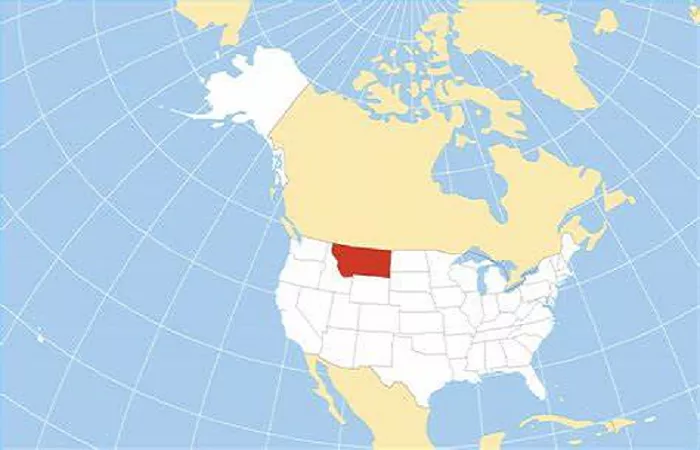Montana, often referred to as “Big Sky Country,” is a state celebrated for its expansive landscapes, majestic mountains, and rich history. Understanding Montana’s geographical location provides insight into its cultural influences, climate, and the diverse ecosystems that define it. In this article, we will explore where Montana is situated on the map, its neighboring regions, and key geographical features that make it unique.
Geographical Location of Montana
Montana is located in the northwestern region of the United States. It is bordered by the Canadian provinces of British Columbia, Alberta, and Saskatchewan to the north, making it the only U.S. state to border three Canadian provinces. To the east, Montana shares borders with North Dakota and South Dakota; to the south, it borders Wyoming; and to the west, it is bordered by Idaho.
The state’s coordinates are approximately 46.8797° N latitude and 110.3626° W longitude. Montana’s vast expanse covers about 147,042 square miles (380,800 km²), making it the fourth-largest state in the U.S.
Neighboring Regions and Accessibility
Montana’s strategic location places it at the crossroads of various cultural and geographical influences. Its proximity to Canada has fostered cross-border relationships, while its position between the Rocky Mountains and the Great Plains has endowed it with diverse terrains and ecosystems.
Major Highways and Transportation:
- Interstate 90 (I-90): This east-west highway traverses the state from the Idaho border in the west to the North Dakota border in the east, passing through cities like Missoula, Butte, and Billings.
- Interstate 15 (I-15): Running north-south, I-15 connects the Canadian border near Sweet Grass to the Utah border in the south, facilitating travel through cities such as Great Falls and Helena.
- Interstate 94 (I-94): This highway enters Montana from North Dakota to the east and continues westward, passing through cities like Glendive and Billings before merging with I-90.
Rail and Air Transport:
Montana is served by several rail lines, including those operated by BNSF Railway, providing freight services across the state. Major airports, such as Billings Logan International Airport and Missoula International Airport, offer commercial flights connecting Montana to other parts of the U.S. and Canada.
Key Geographical Features
Montana’s diverse landscapes are a testament to its unique geological history and climatic conditions.
Rocky Mountains:
The western third of Montana is dominated by the Rocky Mountains, featuring numerous mountain ranges and valleys. This region is characterized by forested areas with species like Douglas-fir, aspen, and Ponderosa pine. The mountains receive significant precipitation, supporting temperate rainforest climates in certain areas.
Great Plains:
To the east of the Rockies lies the Great Plains, a vast expanse of flatlands and rolling hills. This region is primarily used for agriculture, with wheat and barley being prominent crops.
Notable Rivers and Lakes:
- Missouri River: Originating in the Rocky Mountains, the Missouri River flows eastward across Montana, providing water resources and recreational opportunities.
- Yellowstone River: Flowing through the southeastern part of the state, the Yellowstone River is renowned for its scenic beauty and as a habitat for diverse wildlife.
- Flathead Lake: Located in the northwest, Flathead Lake is the largest natural freshwater lake in the western U.S., offering recreational activities and supporting local ecosystems.
Climate and Natural Resources
Montana experiences a continental climate, with cold winters and warm summers. The state’s varied elevations contribute to microclimates, especially in mountainous regions. Montana’s natural resources, including coal, oil, natural gas, and timber, play a significant role in its economy. Additionally, the state’s expansive forests and grasslands support a rich diversity of wildlife, making it a haven for outdoor enthusiasts.
Cultural and Economic Significance
Montana’s location has significantly influenced its cultural and economic development. The state’s proximity to Canada has fostered strong cross-border ties, while its position along major transportation routes has facilitated trade and commerce. Montana’s economy is bolstered by sectors such as agriculture, energy, tourism, and technology. The state’s vast open spaces and natural beauty attract tourists worldwide, contributing to the local economy and promoting conservation efforts.
Conclusion
Montana’s unique position on the map, bordered by Canadian provinces and neighboring U.S. states, has shaped its identity as a land of natural beauty and cultural richness. From the towering peaks of the Rocky Mountains to the expansive plains of the Great Plains, Montana offers a diverse tapestry of landscapes and experiences. Understanding its geographical location provides valuable context for appreciating the state’s history, economy, and the lifestyle of its residents.

